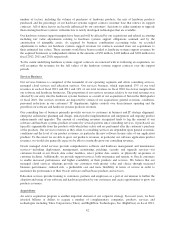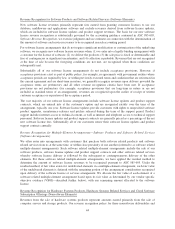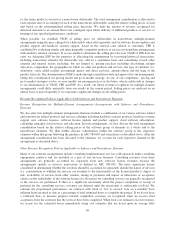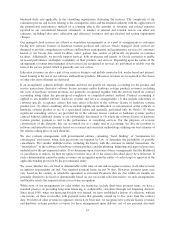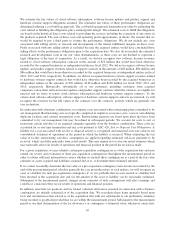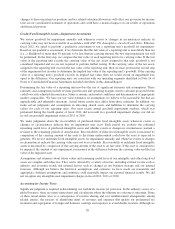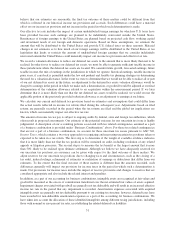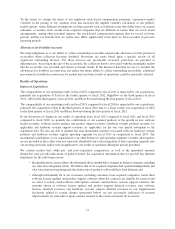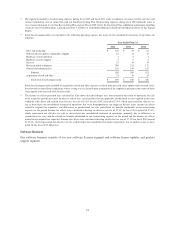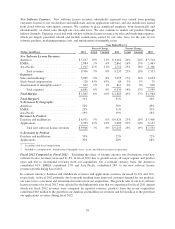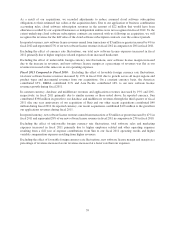Oracle 2012 Annual Report Download - page 56
Download and view the complete annual report
Please find page 56 of the 2012 Oracle annual report below. You can navigate through the pages in the report by either clicking on the pages listed below, or by using the keyword search tool below to find specific information within the annual report.Legal and Other Contingencies
We are currently involved in various claims and legal proceedings. Quarterly, we review the status of each
significant matter and assess our potential financial exposure. A description of our accounting policies associated
with contingencies assumed as a part of a business combination is provided under “Business Combinations”
above. For legal and other contingencies that are not a part of a business combination, we accrue a liability for an
estimated loss if the potential loss from any claim or legal proceeding is considered probable and the amount can
be reasonably estimated. Significant judgment is required in both the determination of probability and the
determination as to whether the amount of an exposure is reasonably estimable. Because of uncertainties related
to these matters, accruals are based only on the best information available at the time the accruals are made. As
additional information becomes available, we reassess the potential liability related to our pending claims and
litigation and may revise our estimates. Such revisions in the estimates of the potential liabilities could have a
material impact on our results of operations and financial position.
Stock-Based Compensation
We account for share-based payments to employees, including grants of employee stock options, restricted stock-
based awards and purchases under employee stock purchase plans, in accordance with ASC 718,
Compensation—Stock Compensation, which requires that share-based payments (to the extent they are
compensatory) be recognized in our consolidated statements of operations based on their fair values. We
recognize stock-based compensation expense on a straight-line basis over the service period of the award, which
is generally four years.
We are required to estimate the stock awards that we ultimately expect to vest and to reduce stock-based
compensation expense for the effects of estimated forfeitures of awards over the expense recognition period.
Although we estimate the rate of future forfeitures based upon historical experience, actual forfeitures in the
future may differ. To the extent our actual forfeitures are different than our estimates, we record a true-up for the
difference in the period that the awards vest and such true-ups could materially affect our operating results.
Additionally, we also consider on a quarterly basis whether there have been any significant changes in facts and
circumstances that would affect our expected forfeiture rate.
We estimate the fair values of employee stock options using a Black-Scholes-Merton valuation model. The fair
value of an award is affected by our stock price on the date of grant as well as other assumptions including the
estimated volatility of our stock price over the term of the awards and the estimated period of time that we expect
employees to hold their stock options. The risk-free interest rate assumption we use is based upon United States
treasury interest rates appropriate for the expected life of the awards. We use the implied volatility of our
publicly traded options in order to estimate future stock price trends as we believe that implied volatility is more
representative of future stock price trends than historical volatility. In order to determine the estimated period of
time that we expect employees to hold their stock options, we have used historical rates of employee groups by
seniority of job classification. Our expected dividend rate is based upon an annualized dividend yield based on
the per share dividend declared by our Board of Directors. The aforementioned inputs entered into the option
valuation model we use to fair value our stock awards are subjective estimates and changes to these estimates
will cause the fair values of our stock awards and related stock-based compensation expense that we record to
vary.
We record deferred tax assets for stock-based compensation awards that result in deductions on our income tax
returns, based on the amount of stock-based compensation recognized and the fair values attributable to the
vested portion of stock awards assumed in connection with a business combination, at the statutory tax rate in the
jurisdiction in which we will receive a tax deduction. Because the deferred tax assets we record are based upon
the stock-based compensation expenses in a particular jurisdiction, the aforementioned inputs that affect the fair
values of our stock awards may also indirectly affect our income tax expense. In addition, differences between
the deferred tax assets recognized for financial reporting purposes and the actual tax deduction reported on our
income tax returns are recorded in additional paid-in capital. If the tax deduction is less than the deferred tax
asset, the calculated shortfall reduces our pool of excess tax benefits. If the pool of excess tax benefits is reduced
to zero, then subsequent shortfalls would increase our income tax expense.
52


